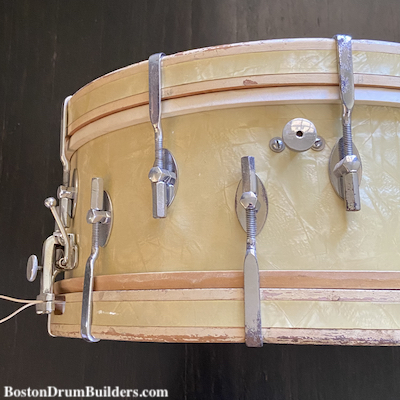Serial Numbers and Makers Labels
Master-Model drums dating from the mid to late 1930s have serial numbers in the mid 9000 range. Around serial number 9000, with nearly 700 Master-Models having already been manufactured, Stone ran out of makers labels the style of which had been in use since January of 1922. Rather than having new labels printed, the factory began using up old stock inclduing repair labels. For this reason, drums produced in the 1930s sometimes have labels matching pre-serial number drums from the late 1910s. In cases where repair labels are used in place of makers labels, the wording is often altered using ink stamps or pencil markings.
| late 1910s Geo. B. Stone & Son Label | Geo. B. Stone & Son Label with 1930s Serial Number |
| Edited Stone & Son Repair Label image source: Reverb | Edited Stone & Son Repair Label |
Washers
Another telltale sign of late production Master-Models is the use of blank oval washers instead of those stamped "STONE & SON / BOSTON MASS". Unstamped washers began appearing on drums with serial numbers in the mid 9500 range.
| early 1920s - mid 1930s | mid to late 1930s |
Leedy Tone Controls
Often mistaken for an aftermarket addition, factory installed Leedy tone controls are common on Master-Model drums of the mid to late 1930s. Stone's use of tone controls roughly coincides with the introduction of blank washers on drums with serial numbers in the mid 9500 range.
Ten Lug Configurations
The use of ten tenioners per head, as opposed to twelve, becomes common on extremely late production Master-Models with serial numbers in the 9600 range. Ten lug models account for only the last few dozen drums manufactured around the late 1930s.
Though not exclusive to the final generation of Master-Models, later examples are more likely to feature pyralin wrapped finishes, deeper shell sizes and chrome plated hardware. Wrapped finishes are included in Stone & Son pricelists as early as 1928 and begin appearing on drums with serial numbers in the low 8000s. Chrome plating, which is not mentioned in Stone & Son's 1932 pricelist, does appear as an option in Booklet "L" published around 1935 suggesting this became an option sometime in the early-mid 1930s. Deeper shell sizes begin appearing on Master-Model drums with serial numbers in the mid 8000 range. Despite being cataloged in only one size (initially 5 1/4" x 14" and later 5"x14") deeper drums account for about 10% of Master-Models produced.
Do you have a Stone & Master-Model? I would love to hear from you! Feel free to drop Lee an email at lee@vinson.net. And for more on the early 20th century snare drum makers of Boston, Massachusetts please visit BostonDrumBuilders.com or follow @old_boston_drums on instagram.










